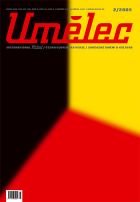| Umělec magazine 2005/2 >> Response to Insiders Inc, an Article Written by Jiří Ptáček (Umělec 1/2005) | List of all editions. | ||||||||||||
|
|||||||||||||
Response to Insiders Inc, an Article Written by Jiří Ptáček (Umělec 1/2005)Umělec magazine 2005/201.02.2005 Gabriela Bukovinská-Kotíková | commentary | en cs de |
|||||||||||||
|
In Umělec magazine, Jiří Ptáček wrote a critical review of the Insiders exhibition, which took place in Brno in the House of the Lords of Kunštát at the beginning of the year, and then in the spring at the Futura gallery in Prague.1 The particularly panning tone in the review, and the article’s supporting arguments, are not particularly persuasive.
The curator of the Insiders exhibition, Pavlína Morganová, has worked for several years in the AVU Research Center in Prague, founded in 1997. Led by Jiří Ševčík, the center is one of the few Czech institutions that has been systematically documenting the contemporary Czech art scene.2 Based on research there, Pavlína Morganová prepared the retrospective curatorial exhibition touching on certain tendencies apparent in Czech contemporary art during the 1990s, such as the interest in everyday life, cheap, not durable materials, and the use of household objects to create ‘recycled’ art. The exhibition catalog addresses this in detail.3 Jiří Ptáček addresses the subject of the exhibition, and he considers the term itself, Insiders, to be inadequately defined. In his text, however, he states, “The fact that the second half of the last decade witnessed a shift from monumental projects to the use of shoddy materials and DIY esthetics, is generally known and has been much reflected upon...” It follows that he grasps the subject, but considers it broadly known, hence insufficiently attractive for an exhibition. This is, nonetheless, a poor argument, since the artists presented at the exhibition had previously presented their work mostly in small, non-commercial alternative spaces, or minor state galleries that are not frequently attended by larger audiences. This time, those ‘older’ works were assembled in a different context. In Brno, it was located in a spacious state museum much visited by the general public; in Prague it was in a spacious private gallery. Thus the opportunity to confront individual works directly in relation to others emerged; this was the curator’s main objective. For such a retrospective, the presentation in Brno was truly significant; the pity is that no state museum in Prague took the show on. In the Brno House of Lords of Kunštát, the exhibition was realized probably only thanks to the enlightened management of its director, Marek Pokorný, who was undaunted in supporting the fresh retrospective, and its young curator. The next rebukes of Ptáček aim at the presence, or rather, the absence of particular artists. The issue itself may be tricky, since in any thematic exhibition, its curator need not present a cross-section of artists, but, on the contrary, only selected works representative of the desired idea. Therefore, it is partially a subjective selection that can be either broadened or limited. There are, naturally, exceptions in the case of established artists who do not fit into the concept; therefore they are missing. Jiří Ptáček, correctly, mentions Federico Díaz and Jiří Černický, who stand outside the observed sphere. But this does not mean that the exhibition theme, how it was formulated and defined, was not significant for that period. At the end the author mentions the 99CZ exhibition, which was prepared by Milan Salák, Jiří David and Jan Kadlec on Wenceslas Square and at the Vyšehrad train station. He recalls it as an example of how such a show better demonstrates the riches of the late 90s alongside its limitations and pitfalls. He even recommends its reconstruction in place of the Insiders. The reasoning is somewhat strange; although the project proved extremely successful, the curatorial goals were, in my opinion, different from the objective defined by Pavlína Morganová. The 99CZ, with its scale and spectrum of artists presented, was more of a biennial. Indeed, as an exhibition with a different aim, it can not be compared with the Insiders. The exhibition should be read as a possible interpretation of the Czech art of the late 90s as a strictly defined specific moment, which played, and today still plays, undoubtedly a crucial role in Czech contemporary art. It would be interesting to compare the period’s tendencies with foreign art, since this comparison is still lacking. All in all, I consider the exhibition a vital event whose meaning is self-evident; this is enhanced with the accompanying catalog, which will be, with its factual texts and precise exhibition list, a foundation for useful discourses, and an important source of further research. Notes: 1. Insiders Inc., Umělec 1/2005, p. 90, House of the Lords of Kunštát, 12. 14. 2004– 1. 30. 2005, Futura gallery, 2. 17.–5. 1. 2005 2. For further information see: http:// vvp.avu.cz, apart from many other activities, the VVP center published in 2001 an extensive anthology Czech Art 1938-1989 (České umění 1938–1989). 3 Insiders, the Unobtrusive Generation of the Late 90s, Prague, 2004, 91 pp., exhibition and catalog concept: Pavlína Morganová, catalog texts: Pavlína Morganová, Jana and Jiří Ševčík, Eva Krátká, David Kulhánek, Dagmar Svatošová. In the catalog the curator explains and illustrates the exhibition. The catalog contains an extensive and precise survey into exhibiting in the 90s, to which Jiří Ptáček adds only a critical sentence. He points out the change of a curator’s name in the case of one exhibition (Chalupáři (Cottagers), 2000).
01.02.2005
Recommended articles
|
|||||||||||||





Comments
[url=http://peopleofpraise.org/hat2.html]15 meters thick about cheap snapbacks[/url]
Add new comment